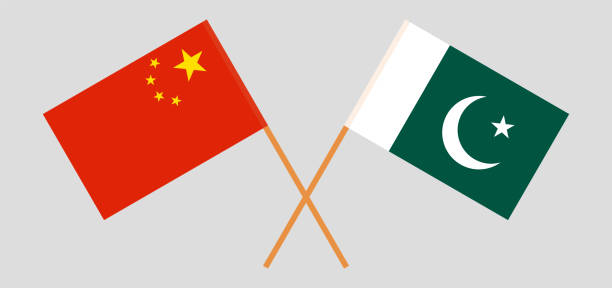
CPEC – AN ECONOMIC GAME CHANGER
CHALLENGES AND WAY FORWARD
Introduction
The China Pakistan Economic Corridor (CPEC) along with
other 5 corridors is a part of (OBOR) one belt one road initiative,aiming in infrastructural
development in more than 60 countries, and traverses across 3000 kilometers
approximately. It spans from Kashgar city of Xinjiang i.e atop of Himalayas down to
Arabian Sea, specifically southern Pakistan’s Gwadar.
CPEC is not merely connecting friendly neighboring countries with roads &
railways but promising hope for gigantic improvement in almost all the major sectors like
Energy, Information Technology, Socio – Economic Development, Industrial Parks,
Cooperation in livelihood areas, Tourism, Person to Person contact and Human
Resource management in Pakistan.
Despite being full of gains, the recent terrorist attack that get killed many Chinese
worker clearly indicates that the enemies are out to fail this project, if they succeed it will
be a great disaster for our economy. To outcome this threat, the government must come
up with comprehensive security cover, ensuring fool proof security of Chinese workers.
The best response to such anti-CPEC ploys will be to further expedite the pace of
Project.
. Aim To discuss the challenges posed to CPEC and recommend way forwards.
. Sequence Sequence, I shall follow is as under :-
a. CPEC – An Economic Booster
b. Analysis - Popping Up Challenges
c. Recommendations for Analysis – Way Forward
d. Conclusion
6. CPEC – An Economic Booster. CPEC, a massive bilateral mega infrastructural
improve & construct project, not only appeared to be a catalyst for the economies
of Pakistan and China but also integrate the countries of the region. The
Infrastructural development will shorten the distance of China to reach Arabian
Sea from 16,000 kilometer to 5000 kilometers. CPEC is a worth 62 billion dollar
project to be completed in 4 difference phases and the 1 st phase is on brink of its
Completion.
CPEC contribution in different sectors is discussed below Energy It spans collaboration in oil and gas, thermal energy projects,
hydropower and renewable power generation projects. According to short
term and long term plans of CPEC, energy sector will be of major focus,
with approximately 38 billion dollars planned to be invested in the sector
with a target to add up to 11,000 – 13,000 MW in a national grid. By now
almost 10 x coal fired and wind farm projects have been completed that
generates approximately 9,000 MW.
Employments The CPEC employment might be one of the biggest
marvels of the Pak-China friendship. China-Pakistan Economic Corridor
(CPEC) through employment generation will help to address the
grievances of unemployed youth. As per an estimate by experts, it is
expected that an increase of about 2.3 million direct and indirect jobs shall
be generated between 2015-2030. As per recent data released by
Chinese Embassy, 80,000 jobs has been created with no forced
withdrawal.
IT Sector - Digital Pakistan. China will assist Pakistan in its IT sector
especially in Artificial Intelligence (AI) in Phase II. With the launch of
CPEC, the installation of 820 kms of fiber optics is also in progress.
Enabling Pakistan for e-commerce & e-governance, electronic monitoring
of border and safe city projects. China will also build Information
Technology Park in Nust H-12 Islamabad with an investment of 1.5 billion
dollars.
Gwadar port will change the faith of Balochistan. As Gwadar Port is
playing a focal role in this project, it will lead the progress and prosperity of
largest and most underdeveloped province of Pakistan: Balochistan.
Gwadar, being a hub port, has modern cargo facilities with 50,000 (DWT)
dead weight tonnage current capacity of port, that allow it to meet the
increasing challenge of the world of trades. Current developments at
Gwadar like international airport,
Aparts from above mentioned major contribution is also being made in
tourism, agricultural development and poverty elevation, trade and
industrial parks and financial cooperation.
Analysis – Challenges. The CPEC is associated with the national and
international geopolitics and is undergoing numerous vulnerabilities with regard to its
transparency and control to a path of sustainable development from internal (within
Pakistan) and external (out of Pakistan) powers. It is always important to gauge the
spectrum of internal and external threat, so that can be dealt timely.
a. External Challenges. These challenges ranges from prevailed the
unstable situation in Afghanistan, competing interest of immediate
neighbor like India and Iran, US concern about China’s growing
supremacy in the special Indian ocean. External challenges are
discussed as below:
i. India. Pakistan’s security analysts view India-Pakistan relationship
as a zero-sum game and, thus, believe India resists any kind of
improvement in Pakistan. India has denied to join the CPEC on
ground that it passes through the territory that is disputed between
Pakistan and India. The Indian leadership has objected the project
and Indian Prime Minister Modi even requested the Chinese
President during the former’s visit to China to abandon the plan.
Conservative political and security experts in India take the CPEC
investment as having negative geopolitical implications for India in
long-term. Second, the China-Pakistan relationship presents a
challenge to India’s desire to become a regional hegemon. To
counter the growing influence of China in the region, energy-hungry
India is investing in Iran’s port of Chabahar, 72 kilometers west of
Gwadar port, and plans to build a corridor through Iran and
ii.Afghanistan. The Pakistani leadership believes that India is
involved in funding and planning anti-state activities in Pakistan,
especially to disrupt the CPEC project. Arrest of Kulbushan Yadav,
an Indian naval officer serving in the premier Indian intelligence
agency, RAW, from Balochistan, proved Pakistan’s claims. The
Indian spy has confessed about Indian involvement in the
destabilization of Balochistan, Karachi, and KPK. Ehsan Ullah
Ehsan, who surrendered to the security forces on April 16, 2017,
has revealed the involvement of the Indian spy agency RAW in
funding and supporting the terrorist groups to destabilize the
Pakistan in general and CPEC in particular. In this current regional
environment, it appears that India will continue as a spoiler until it is
engaged proactively and integrated into the regional economic
framework.
Afghanistan. The continuous uncertainty in Afghanistan and
its porous and unmanaged border could dent the security
environment in both Pakistan and the western regions of China.
Pakistani security officials view India’s RAW and Afghanistan’s
National Directorate of Security (NDS) joint collaborations behind
terrorist activities in Pakistan to delay and disrupt CPEC by creating
instability. The Uighur militants are demanding a separate ‘East
Turkistan’ state from China, considering themselves closer to the
Central Asian states. These terrorist groups have already attacked
and kidnapped Chinese workers and engineers in the past and
warned to further expand their operations against Chinese
interests. For China, security and stability in Afghanistan are
equally important for its massive investment in the region. China is
acutely concerned as a destabilized Afghanistan can affect China’s
western Xingjian province, a key stakeholder in the materialization
of CPEC.
iii. Iran. Initial response from Iran to CPEC flashed that it was
apprehensive about the development of Gwadar as a deep-sea port
and took the project as a rival to its Chabahar port in the mouth of
the Strait of Hormuz, built with Indian assistance. However, Iran
realized significance of CPEC and has shown its desire to be part
of CPEC. Iran has also invited Pakistan to join the Chabahar Port
trilateral agreement and also assured Pakistan that “Chabahar is
not a rival to Gwadar.” On the other hand, security analysts believe
that Saudi-Iranian enmity could obstruct the improvement in
Pakistan-Iran relations. While Pakistan needs Iran to fulfil its energy
requirements, Pakistan cannot risk isolating itself from the Saudis
by moving too close to Iran.
iv. United States. Contrary to the common opinion in Pakistan,
the U.S. government has not opposed CPEC and its desire to see
the CPEC as a multilateral project is an encouraging sign.
However, the United States is aware of the apparent strategic
consequences of the CPEC project. Chinese development of
Gwadar port may face the U.S. government’s opposition as
operational control of the Gwadar port gives clout to Chinese naval
power in the Indian Ocean, a potential threat to the supremacy of
U.S. naval forces currently enjoy in the Indian Ocean. Outwardly,
the United States is encouraging and supporting Indian naval
power to counter the growing Chinese influence in the Indian
Ocean. On the other hand, cooperation in Afghanistan has been
one of the high points in U.S - China bilateral relations in recent
years as the United States fears Russia regaining its control of its
former states—the CAR states—in the post NATO withdrawal
scenario.
. Domestic Constraints The internal security situation and the lack of
political consensus in Pakistan are the two main challenges that may
impede the completion of the CPEC project. If not dealt aptly, these
impediments can affect national development and Pakistan’s economic
integration in the region as envisioned for CPEC.
i. Internal Security. The major security apprehensions in Pakistan
today are: religious extremism perpetuated by Taliban militants in
the tribal areas and KPK, sectarian and ethno-political violence in
the metropolitan city of Karachi and Quetta; a separatist insurgency
in Balochistan, fueled by foreign anti-state forces; provincial
infringements and the law and order situation. Security analysts
expressed that foreign funded extremists can target the CPEC-
related projects. In addition to the external terrorist threats, various
anti-state local terrorist groups such as TTP, JuA, Lashkar-e-
Jhangvi (LeJ), the Balochistan Liberation Army (BLA), the
Balochistan Liberation Front (BLF), are looming threats to the
Pakistani state. The local population of Balochistan has old
grievances about political and economic deprivation. Balochs fear
that outsiders will come in and turn the native Balochs into a minority
and also they have kept eye on their rich land resources of
Balochistan. The sentiments has always been exploited by
insurgents, and these insurgents oppose any developments and
have attacked many Chinese nationals in the past. They have
frequently blown up gas pipelines and trains in order to deter the
non-local investors in general and Chinese developers in particular.
In April 2015, Baloch militants killed at least 20 non-local laborers in
the remote town of Turbat, Balochistan, a week prior to the Chinese
president’s visit to Pakistan. Hence, it becomes a real challenge for
Pakistan not only to root out these terrorist groups and their
infrastructure but also to unearth their supporters, sympathizers and
facilitators across the country.
ii. Political Dynamics. Political hurdles within Pakistan can also
derail the execution of the CPEC project. Though, there is an
accord of major political parties in Pakistan on the benefits of CPEC
and all political parties pledged their political ownership to CPEC.
Still, there is a political controversy among various parties mainly
on the selection of the route and the allocation of the resources
related to the CPEC project. Underdeveloped provinces like Khyber
Pakhtunkhwa and Balochistan accuse the federal government of
changing the original route on the pretext of security, which would
only benefit more developed Punjab. History reveals that political
gains take precedence over national interest, and issues like
allocation of funds have always been politicized. Moreover, the lack
of limpidity and confidentiality in assigned deals is yet another
concern, which has elevated worries among political parties and
other stakeholders who have demanded the government to make
all CPEC-related agreements public.
Recommendation – Way Forward
Diplomatic Domain. Regional alliances are changing rapidly, that
have changed regional dynamics. Hence, Pakistan and China must follow
the developing geopolitical situation and modify their strategies
accordingly to respond meritoriously to the implementation of the project.
By mutual trust and support, Pakistan and China may succeed to face the
potential obstacles, formed by the regional environment. Nevertheless, in
the long term, success of CPEC is not only limited to the bilateral actions,
but also to China and Pakistan’s diplomatic policy in gathering support and
cooperation from regional countries. Diplomatic efforts through the
process of dialogue should target to highlight the economic dividends of
CPEC for the whole region.
India. India being the almost open rival of CPEC has to be
dealt rationally, the potential may be extended to India through
Punjab and Sindh via the eastern corridor. Accommodating India in
the CPEC and allowing it to play an active role is likely to change
India into an essential stakeholder, ensuring the success of the
project. CPEC can also help bring about the much awaited Iran-
Pakistan-India gas pipeline, addressing India’s energy needs. The
mutual inter-dependency thus developed will result in an improved
security situation and economic integration benefiting not only India
and Pakistan but the whole of South Asia. Similarly, Pakistan
should also use the platforms of the SAARC and the SCO to follow
incorporation of India into a cooperative regional economic
framework.
Afghanistan. Both Pakistan and Afghanistan, instead of
accusing each other of creating instability in their respective
countries, both countries should pursue a solution to their mutual
differences through dialogue. They must address common issues
such as cross-border terrorism and smuggling through better
border management. Pakistan should continue to encourage
Afghanistan not to let any state or non-state actor use its country
for disruptive activities against Pakistan and pledge the same to it.
The positive Chinese role in Afghanistan to achieve political
reconciliation and stability could in turn also contribute in boosting
Pakistan-Afghanistan diplomatic as well as economic relations.
Iran. Since the economic sanctions on Iran have been lifted,
Pakistan and China need to integrate Iran in the economic projects
for the mutual benefit of all the involved stakeholders. Iran’s support
of CPEC would result in improved mutual interdependence and
shall promote regional stability. Throwing away the regional
proxies, Pakistan should proactively work to complete the
Iran–Pakistan gas pipeline. Iran has almost concluded the job
inside Iran up to Pakistan’s border with an investment of $2 billon.
With the beginning of this new economic alliance Iran can give
surety to Pakistan to assist in its stability by denying Iran’s soil for
Indian activities in Balochistan.
United States. Though role of US seems to be neutral, yet
Pakistan should play its role in regional and global harmony
through balanced and positive diplomatic engagement with both
China and the United States. The CPEC platform is the right
opportunity to foster trilateral cooperation among the United States,
China, and Pakistan. The U.S. government can also help Pakistan
by encouraging and providing incentives for U.S. firms to invest in
Pakistan.
b. Domestic Domain. Definite success of the CPEC is directly
proportional to timely completion of the project, to reap the factual benefits
of economic prosperity, stability, and an improved quality of life for its
people, Pakistan must keep its house in order for timely implementation of
the project.
Internal Security. Because the paybacks of CPEC are related to
its timely completion, internal peace and stability are thus
significant for successful implementation of the project. To deal with
the security situation permanently, the federal government, with the
help of provincial governments and security agencies, must
religiously implement the strategy involving both hard and soft
powers. Civil law enforcement agencies (FC and Ranger) can now
manage the CPEC-related security with the help of a dedicated
security apparatus for that purpose. However, for inter service
collaboration fusion cells need to be established along the routes
depending upon the intelligence gathering of specific area. Swift
intelligence sharing and quick responses will enhance the overall
security environment by engaging local and foreign supporters,
facilitators, sympathizers, and financiers of the terrorists. Moreover,
Provision of incentives to locals and making the local people
stakeholders in the project would result in a secure environment,
leading the success of the project.
Provincial Accord. CPEC shall be declared as a national
entity, the government must take special steps to address the
grievances of smaller provinces that feel downgraded, especially
KPK and Balochistan. To oust the negative opinions and fears
relating to the project, the federal government should also address
the honest concerns and grievances of the local population in
Balochistan. The local populace in underdeveloped areas such as
Balochistan and Gilgit-Baltistan should be offered special incentives
in the project to embrace them into the national mainstream.
Government should ensure representation of all the provinces,
including Gilgit-Baltistan, as part of the decision-making body to
make the process transparent. Any attempt of favoritism in the
process shall be all out dejected. Also an effective observing and
implementation body is required to strictly scrutinize the project’s
implementation, ensuring timely completion with no compromise on
quality of all the projects.
Conclusion CPEC brings a new kind of China-Pakistan cooperation with
the potential to further fortify the two countries’ political and economic relationship. The
project has strategic and economic significance for South Asia in general and both
China and Pakistan in particular. The projects worth US 62 billion dollars provide an
opportunity for Pakistan to address some of the main problems to its economic growth,
such as the narrow foreign investment, energy crisis and poor communication
infrastructure. CPEC may bring peace and stability to the country in general and
Balochistan in particular through socio-economic development. Despite the significance
of CPEC, the project is facing various internal and external challenges. The success of
the project particularly depends upon regional geopolitical issues, especially India’s
place on the project and Afghanistan’s instability and its effects on Pakistan. Internally,
Pakistan needs to deal with security challenges and political/ provincial grievances with
regards to route selection, which may hamper the implementation of the project.
Nonetheless, in the long run, timely and transparent implementation of the CPEC
project has the potential to elevate the socioeconomic condition of Pakistan and the
region.
Leave a Comment
Related Posts
-
18 May 2022
-
18 May 2022
-
20 May 2022
Sign up for free, explore fun and knowledgeable content, and make your own portfolio!
🟢All System Operational
© 2022 - 2024 Freelancing by Fay.
Design by Limitless Technologies Pakistan - All rights reserved.


1663566630.png)




0 Comments